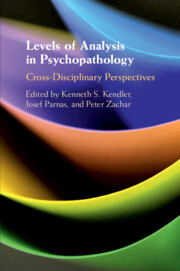Book contents
- Levels of Analysis in Psychopathology
- Advance Praise for Levels of Analysis in Psychopathology
- Levels of Analysis in Psychopathology
- Copyright page
- Contents
- Figures
- Tables
- Contributors
- Preface
- General Introduction
- Part I Neuroscience, Mechanisms, and RDoC
- Part II Phenomenology, Biological Psychology, and the Mind–Body Problem
- Part III Taxonomy, Integration, and Multiple Levels of Explanation
- Section 8
- 22 Introduction
- 23 Descriptive Psychopathology: A Manifest Level of Analysis, or Not?
- 24 Psychiatry without Description
- Section 9
- Section 10
- Section 11
- Section 12
- Section 13
- Section 14
- Section 15
- Index
- References
24 - Psychiatry without Description
from Section 8
Published online by Cambridge University Press: 02 April 2020
- Levels of Analysis in Psychopathology
- Advance Praise for Levels of Analysis in Psychopathology
- Levels of Analysis in Psychopathology
- Copyright page
- Contents
- Figures
- Tables
- Contributors
- Preface
- General Introduction
- Part I Neuroscience, Mechanisms, and RDoC
- Part II Phenomenology, Biological Psychology, and the Mind–Body Problem
- Part III Taxonomy, Integration, and Multiple Levels of Explanation
- Section 8
- 22 Introduction
- 23 Descriptive Psychopathology: A Manifest Level of Analysis, or Not?
- 24 Psychiatry without Description
- Section 9
- Section 10
- Section 11
- Section 12
- Section 13
- Section 14
- Section 15
- Index
- References
Summary
This commentary on Peter Zachar’s chapter on the issue of description is concerned with the nature and role of description in contemporary psychiatry: It is argued that the so-called operational revolution entailed severe epistemological problems leading to a crisis of description, and hence a more general problem of classification and research. Language in psychiatry, unlike in somatic medicine, does not operate with fixed referential terms but is more concerned with meanings. In other words language in psychiatry plays an important constitutive role. Thus, a description derived from the medical model and transposed into psychiatry exerts devastating consequences, briefly illustrated by a few psychopathological examples.
- Type
- Chapter
- Information
- Levels of Analysis in PsychopathologyCross-Disciplinary Perspectives, pp. 297 - 302Publisher: Cambridge University PressPrint publication year: 2020

